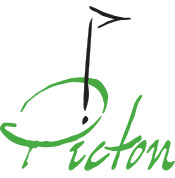Welcome to the Picton Golf BLOG
Can You Speak 'Golf'? Find The Complete Beginner’s Guide to Golf Terminology Here

Can You Speak 'Golf'? Find The Complete Beginner’s Guide to Golf Terminology Here
You just bought your first set of golf clubs and are excited to join your friends on their favourite local golf course in Picton, Ontario! You lace up your golfing shoes, slip on your exceptionally grippy gloves and head out onto what your caddie labelled the “fairway”.
You make your first swing and one of your buddies yells “fore!”. And, surprising yourself, hit the ball dead on!
But it goes in the complete opposite direction of where you were planning. Everyone is chuckling, “should we give him a mulligan?”, and allow you to re-swing.
This time with far better luck!
Your friends are jokingly calling you “Ace” as you line up your next swing and the game continues until someone starts calling out, “Birdie, Birdie!”.
The game seems to be going quite well, but you don’t recognize any of these strange words. In fact, you’re wondering what’s come over your friends and their strange choice of vocabulary. What on earth is everyone talking about?
Your Complete Guide to Golf Terminology: For Beginners
Every sport comes with its own unique vocabulary - golf especially! And it only takes a few minutes on the fairway to notice this seemingly exclusive lingo.
Whether you’re talking about the score, the playing field or the off-hand jargon that every professional seems to keep in their back pocket, golf terminology is its own language entirely. But to the beginner athlete, some of these golf terms probably sound quite strange. After all, is ‘mulligan’ even a word?
In the world of golf, absolutely! That and many others.
But don’t worry. Everyone was once a beginner in this sport and these terms, although odd, are easy to learn.
First, Let’s Get The Lay Of The Land
Understanding the different parts of a golf course is extremely important. Only then will you understand where you should be aiming and why!
First up, the fairway!
Fairway
The fairway is where you should be aiming. This area of carefully trimmed grass lies between the tee box (the location of your tea) and the green.
Ontario Golf courses keep this area of grass short, making it easy to:
- Find your ball.
- Make a clear swing.
- Aim.
- Predict the outcome of your shot.
Green
The green is exactly where you want to end up. This is the area where the hole and flag are. It’s located at the end of the fairway.
Golf courses keep the green mowed even shorter than the fairway grass to make a putt-in easy and smooth.
Rough
The rough is where you do not want to be. It’s the longer grass that surrounds the fairway and green.
Pro Tip: If you’re hitting from the rough, best get your mightiest club!
Hazard
A hazard is an area on a golf course marked with red or yellow stakes. These can include both natural hazards and manmade hazards.
Examples of natural hazards:
- Lakes
- Ponds
- Creeks
- Rivers
- Trees
- Thick Vegetation
If you can hit the ball out of the hazard, you won’t receive a penalty. But, if the ball cannot be found/removed from the hazard, you will have to take e a penalty stroke.
Bunker (AKA the Kitty-Litter!)
The bunker is essentially a sandbox, but not one you want to play in. This hallow is filled with sand and is designed to be an obstacle. If your ball gets stuck in the bunker, you’ll need to adjust your swing (making it a little ‘fat’) and ensure you have enough power in your follow-through to drive it out.
Sandtraps are considered a manmade hazard. But with this specific hazard, you are permitted to hit the ball out of the sand without taking a penalty.
Second, Let’s Learn How To Keep Score
Now that you know your way around the golf course, we can begin learning how to keep score of your points.
Did you know: In a game of golf, you should be aiming for the LEAST amount of points as possible, rather than the MOST. A lower number of points means it took you fewer swings to sink the ball!
Par
Par is the most important scoring term to understand in golf. Why? Because everything is based on it!
Par is the average number of shots a golfer SHOULD make to complete a hole. If a hole is given a higher difficulty level, it will have a higher par. If it’s a rather easy hole. It will have a lower par.
The closer you are to par, the better!
Birdie
If you scored a birdie, you took one less shot than par to sink the ball.
For example, if you were playing a par-5 hole and it only took you 4 strokes to sink the ball, then you scored a birdie!
Bogey
A bogey is one more than par.
For example, if you were playing that same par-5 hole and it took you 6 strokes to sink your ball, you’ve scored a bogey.
Double Bogey
A double bogey is two shots above par.
Triple Bogey
A triple bogey is three shots above par.
Eagle
An eagle is 2 shots below par. This means that on a par-5 hole, you only needed 3 swings to sink your ball.
Double Eagle (Albatross)
A double eagle is 3 shots below par.
Hole in One (Ace)
This is the best score you can get!
If you scored a hole-in-one, it took you one single stroke to sink your ball into the hole from the tee.
Funny and Useful Golf Terms For Your Back Pocket
Now that we’ve levelled the playing field and understand how to keep score, it’s time for the fun part!
Below are some common golf jargon that golfers use frequently while playing. It’s easy to pick up on the go, but we’ll give you a bit of a head start with some of the more common terms.
Mulligan
A mulligan is your best friend. This unofficial re-swing is usually given to beginners, as it gives them a second chance at their shot.
Gimme Putt
The common “gimme putt” phrase is actually a request given to fellow golfers. If you putt the ball extremely close to the hole, but it fails to sink, someone might ask that it simply be considered completed.
Chunk
A chunk swing (or fat stroke) is when you hit just behind the ball. It usually creates a large divot in the ground.
Thin
A thin stroke (or skinny stroke) is the opposite of a fat stroke. It occurs when your clubhead hits the ball too high.
Shank (‘the S word’)
A shank is a stroke that hits the ball with the neck or heel of the club. Careful, it’s said to be contagious!
Yips (‘the Y word’)
Yips are usually brought on by sudden nerves. The yips can be either,
- A muscle spasm, or
- A mental block.
Both of which prevent a golfer from making a successful swing.
Fried Egg
A fried egg is when your golf ball ends up partially buried in the sandtrap.
Are You a Beginner Golfer? Become a Picton Golf & Country Club Member Today!
Picton Golf & Country Club is so excited to be welcoming new members in 2022!
If you haven’t had had a chance to register, now is the time!
We offer:
- Men’s Leagues
- Women’s Leagues, and
- Mixed Leagues!
Picton Golf & Country Club: Member Highlight
Congratulations Casey Ward!
Another past Club Champion, Casey Ward continues her very successful career as Director of Instruction at the Credit Valley Golf & Country Club. Casey crowned her season off this year as the recipient of the 2021 George Knudson PGA of Ontario Teacher of the Year.
Well done, Casey! We are very proud of you and look forward to following you in 2022.

